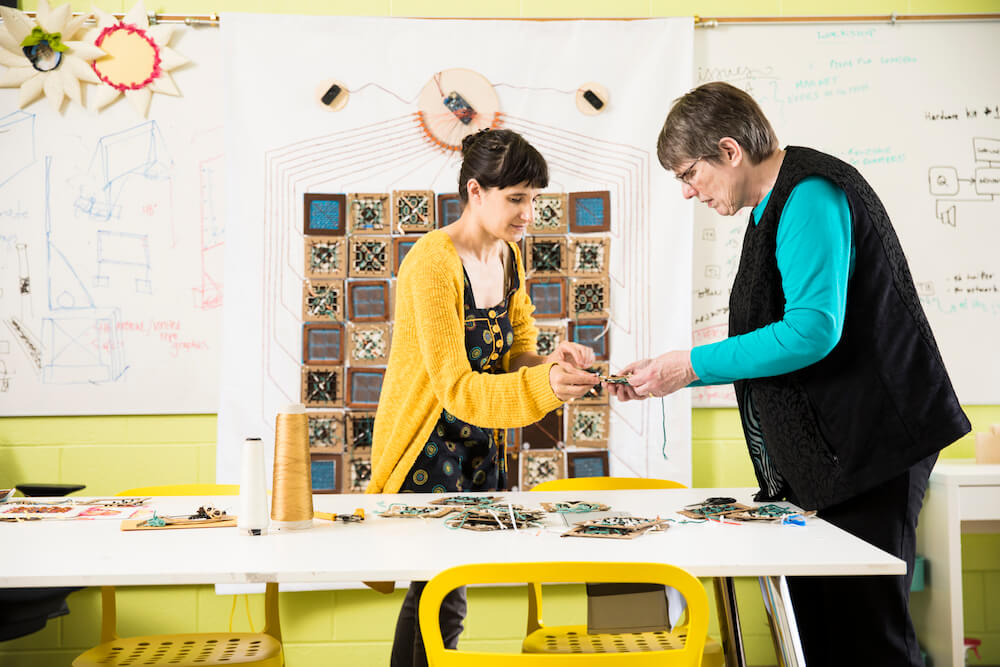Critical Fabulations: Ways of Storytelling with Daniela Rosner in Review and in Conversation
Yana Boeva
July 23, 2018 | Reflections, Reviews
 What would it take to redefine design as a practice and discourse? Doubtless, a lot if one did not know where to begin. Daniela Rosner’s book Critical Fabulations shows where but also explains how to redefine design for a different, yet possible future by bringing to mind neglected histories of practice which co-constitute it. We spoke with Daniela Rosner about her new book and her proposal for critically fabulating beyond the dominant narratives of design and innovation.
What would it take to redefine design as a practice and discourse? Doubtless, a lot if one did not know where to begin. Daniela Rosner’s book Critical Fabulations shows where but also explains how to redefine design for a different, yet possible future by bringing to mind neglected histories of practice which co-constitute it. We spoke with Daniela Rosner about her new book and her proposal for critically fabulating beyond the dominant narratives of design and innovation.
One place to start with is NASA’s “Little Old Ladies,” a group of women whose wire weaving work fabricated information storage, the so-called core memory, for the Apollo missions. While much is known about their male counterparts’ work, these women found little recognition for their craft practice outside the history of technology, and even less as an equivalent form to design work that contributes to the production of technology. Her collaborative research project Making Core Memory with Bay Area master quilter Helen Remick works to uncover such absences. Together with her research team, they integrated quilting and weaving to rethink how technology production could be done differently.
Her book, however, is not about history in and of itself. Rather, it resorts to the history of design and technology production with their maxims. Drawing on historian Saidiya Hartman’s definition of critical fabulation as the moment to open up counterhistories, Rosner expands the concept towards contemporary design practice through material explorations. Critical fabulations, for her, work as “ways of storytelling that rework how things that we design come into being and what they do in the world” (17). To make design a different thing, she notes that two interventions are needed. The first requires delving into the history of design with its dominant traditions, namely individualism, objectivism, universalism, and solutionism, to locate different methods and approaches for designing technology. The second intervention expands those following the alternative stories with “an initial set of orienting tactics” (81) that include alliances, recuperations, interferences, and extensions.

Daniela Rosner & Helen Remick preparing the Making Core Memory Quilt. Photo credit: Mark Stone.
This move also defines the book’s structure from a review of design’s intellectual traditions in chapter one to current modes of intervention (chapters three to five). The review commences with Herbert Simon’s design science and ends with Silicon Valley’s contemporary technology design strategies as well as the more recent approaches in critical and speculative design. Rosner provides many evocative contemporary examples including a local knitting guild in San Francisco, Lilly Irani and Six Silberman’s Turkopticon system, Sara Zewde’s artistic project Ecologies of Memory in Brazil, or her own collaboration on a feminist hackerspace zine. In-between past and present, chapter two introduces the work and ideas of two well-known figures of feminist technoscience—Lucy Suchman and Donna Haraway—to the field of HCI and design engineering.
Throughout the book, Rosner weaves in autobiographical elements of her experience as a designer and ethnographer to unwrap the framework of critical fabulation as a path of one person’s transformation. On working with mixed theories, methods, and materials, but also time trajectories, in the concluding chapter, Rosner points out that their combination allows “to pose entangled orientations that diffract and deflect their wider epistemic cultures” (124-25). The book thereby sets up new possibilities for design and technology production to rethink and redefine their entangled approaches with history, power, and gender. With its material examples and theorization, it offers a much more imaginative way of analyzing in science and technology studies. Critical Fabulations excels in introducing design as a practice and a discourse, and is accessible for those who aren’t interdisciplinary, or practice-led.
YB: A captivating element in your book are the multiple ‘histories’ of practice that remain unacknowledged as design work. You illustrate that through different material-based projects such as the Making Core Memory or the knitting guild. But instead of pairing them with other technology projects, you counter them with design’s disciplinary and epistemological historiographies, and then again with the “feminist reworkings” through Lucy Suchman and Donna Haraway’s scholarship. How did you make these connections for your research and design work?
DR: Yes, you describe just the sort of intervening I hope to do. I’m trying to rework not just the design outputs or technology projects themselves, but also the methods people take up to do those projects. Designers need ways of taking into account the wider historical and political worlds their practices intentionally or unintentionally affect (shape, extend, banish). For me, this involves understanding the stories proposed, those used to communicate, and those that live on through continued practice. The book comprises only one set of stories that relay my own intellectual journey through and with design. But my hope is that this example sets up opportunities for others to critically fabulate through design.
I began making those connections while working on a project called Spyn (a story I recount in chapter 3). Working with Kimiko Ryokai, I developed a tool that let people embed digital stories while knitting. They used a handheld device to store and recall photos, videos, text, and locations associated with specific areas of knit fabric. After several trials with people in the Bay Area I learned of some serious concerns around the role technology should play in this needlecraft practice. Where some people (several young, relatively affluent, able-bodied) delighted in the resulting experiments (creating a recipe out of a scarf or a puzzle out of a vest), others (comparatively older and lower social class) felt the technology render them (their skillset, bodies, lives) less visible. So the project invited me to examine some of the assumptions underlying my tech development tools and what other ways of designing might be possible.
YB: The book’s emphasis is not on the history of innovation but about modes of intervention in design practice. One mode is the personal narrative connected to autobiography. What motivated your decision to interweave your narrative into the entire project?
DR: Early on I knew that I wanted to play with form, to invert the typical representation of argument, to embody some of my proposed approaches. An important aspect of this work involved following a longstanding feminist impulse to embrace subjectivity, to present the situated nature of knowledge. This meant making the personal both political and analytical. By exploring how my own story and biography to some extent shaped the arguments I crafted, and by letting the argument take shape as a kind of fabulation, I let my story thread into the work ahead. The book resists the passive voice, for example, to highlight the actors doing the work. But I also aimed to shift my voice from that of the removed narrator to that of someone involved in the making of narrative, argument, and world.
This also relates to your prior question. I’ve found that telling this story through my own experience helps move beyond many of the dualisms that organize design. For example, designers continually fluctuate between visionary approaches (wherein the valorized expert designer devises an outcome) and participatory approaches (wherein the designer takes on the role of the facilitator, giving voice to those around them). I could have begun with projects and a description of their failings, or I could have countered the failings of design with instrumental alternatives. I wanted the cases to represent something beyond these reproductions of the problem-solution paradigm—to “narrate a certain impossibility,” in Saidiya Hartman’s terms.
YB: Your research and the book’s contexts are North American. But your work also aligns with recent scholarship and discussions on changing the practices and perspectives of design, especially in our current systems of capitalism, by acknowledging the other/s. I’m thinking of Arturo Escobar’s Designs for the Pluriverse (2018), the Decolonising Design research group, Deepa Butoliya’s work on critical jugaad (the Hindi word expressing the act of making do with what is at hand), and the ontological designing research initiated by Tony Fry and Anne-Marie Willis at the aptly named The Studio at the Edge of the World in Tasmania. Yours and their work seem to have found what you call in your conclusion’s subtitle “an elsewhere.” How can we as scholars, designers, investigators, the inquisitive, transform “the elsewhere” into “the present”? What other work can STS scholars offer beyond writing to support critical fabulations?
DR: Yes, there’s such a rich tradition of work to build on in this domain. STS scholars are also nicely positioned to partner with people (activists or artists, for instance) already doing the work of expanding and readjusting methods of inquiry and dissemination. Such collaborations could unfold in many different ways — from shaping policy proposals, to re-politicizing design projects, to expanding pedagogical toolkits in the classroom (beyond the seminar). I’m currently working with communications scholar Samantha Shorey and several high school educators, for example, on an expanded version of our Making Core Memory workshops that resituate the limits of prevailing design and engineering narratives for new audiences.
YB: The book introduces a new framework to understanding design in various ways with a set of orienting tactics like alliances, recuperations, interferences, and extensions. Each one is illustrated with a specific project, either yours or by others. Together they form a call for responsible action. It seems difficult, however, to implement that in design practice and education, where you have a stark opposition with corporate methods such as IDEO’s design thinking and their institutionalization. As you write, critical fabulations are easier said than done. What would it take to unsettle the norms, to set design on a new course?
DR: There’s no easy answer here, and in many ways, this is the question I ask throughout the book. I’ve argued that to set design on a new course, we in STS need to continuously reckon with the stories that underpin design—revising the matters we make matter, to borrow from Haraway.
There’s currently some hope in doing that work of unsettling with campaigns aimed at generating awareness around corporate military contracts, regulating the managerial control afforded by networked sensors, and disrupting the wider neoliberal project built into material practices. Some in the design and technology industries are asking hard questions around racialization, gender, and disability. But it mustn’t stop there. We can’t have the same people in power and expect design justice. We need to recognize the ways design histories make design presen
YB: Thank you for your time, Daniela!
Published: 07/23/2018
